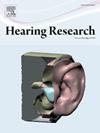镫骨位移和耳蜗内压对极高音量声音反应的频率依赖性和谐波失真
IF 2.5
2区 医学
Q1 AUDIOLOGY & SPEECH-LANGUAGE PATHOLOGY
引用次数: 0
摘要
以前的报告表明,在中高声压级(130 dB SPL)的声音下,耳蜗底部测得的蜗内压(PIC)与镫骨位移(DStap)成正比增加。与这一假设相一致的是,我们的报告显示,对于低频声音(1 kHz),镫骨位移和耳蜗内压在中等高声压级(130 dB SPL)时随声压级(SPL)呈线性增加,但在较高暴露声压级(130 dB SPL)时达到饱和。为了进一步研究这种频率和电平依赖性,我们在进行乳突切除术和扩大面部凹陷以暴露听骨链的尸体颞骨中测量了 DStap 和 PIC。在前庭(PSV)和鼓室(PST)测量 PIC 的同时,还测量了外耳道(PEAC)的声压级和镫骨速度(VStap)的激光多普勒测振仪(LDV)。与之前的报告一致,DStap 和 PSV 随耳道内声压级成比例增加,直到与频率相关的饱和点。同样,虽然 DStap 和 PSV 的渐近值和发生饱和的声压级都与频率有关,但在所有频率上,随着声压级的增加,增益随声压级的增加而降低,在驱动频率的谐波处的响应幅度随声压级的增加而增加,这与通过峰值削波产生的谐波失真一致。重要的是,这种非线性失真将到达内耳的能量转移到比入射刺激更高的频率上,从而使听觉系统的高频敏感元件受到比单独测量该刺激所预期的更多噪声的影响。总之,这些反应表明,耳蜗对极高频率空气传导刺激的表征受到中耳非线性的限制,这种峰值限制导致耳蜗暴露的高频率高于驱动刺激。本文章由计算机程序翻译,如有差异,请以英文原文为准。
Frequency dependence and harmonic distortion of stapes displacement and intracochlear pressure in response to very high level sounds
Previous reports have suggested that intracochlear pressures (PIC) measured at the base of the cochlea increase directly proportionally with stapes displacement (DStap) in response to moderately high (<130 dB SPL) level sounds. Consistent with this assumption, we have reported that for low frequency sounds (<1 kHz), stapes displacement and intracochlear pressures increase linearly with sound pressure level (SPL) for moderately high levels (<130 dB SPL), but saturate at higher exposure levels (>130 dB SPL). However, the magnitudes of each response were found to be frequency dependent, thus the relationship between DStap and PIC may vary at higher frequencies or higher levels.
In order to further examine this frequency and level dependence, measurements of DStap and PIC were made in cadaveric human temporal bones prepared with a mastoidectomy and extended facial recess to expose the ossicular chain. PIC was measured in scala vestibuli (PSV) and scala tympani (PST) simultaneously with SPL in the external auditory canal (PEAC) and laser Doppler vibrometry (LDV) measurements of stapes velocity (VStap). Consistent with prior reports, DStap and PSV increased proportionally with sound pressure level in the ear canal up to a frequency-dependent saturation point, above which both DStap and PSV showed a distinct deviation from proportionality with PEAC, suggesting that their relationship may remain constant at these high frequencies. Likewise, while the asymptotic value, and SPL at which saturation occurred were frequency dependent in both DStap and PSV, the reduction in gain with increasing SPL above this level was constant above this level at all frequencies, and the magnitude of responses at harmonics of the driving frequency increased with increasing level, consistent with harmonic distortion via peak clipping. Importantly, this nonlinear distortion shifts the energy arriving at the inner ear to higher frequencies than are present in incident stimulus, thus exposing the high frequency sensitive components of the auditory system to more noise than would be expected from measurement of that stimulus on its own. Overall, responses suggest that the cochlear representation of very high-level air conducted stimuli is limited by nonlinearities in the middle ear, and that this peak limiting leads to increased high frequency cochlear exposures than are present in the driving stimulus.
求助全文
通过发布文献求助,成功后即可免费获取论文全文。
去求助
来源期刊

Hearing Research
医学-耳鼻喉科学
CiteScore
5.30
自引率
14.30%
发文量
163
审稿时长
75 days
期刊介绍:
The aim of the journal is to provide a forum for papers concerned with basic peripheral and central auditory mechanisms. Emphasis is on experimental and clinical studies, but theoretical and methodological papers will also be considered. The journal publishes original research papers, review and mini- review articles, rapid communications, method/protocol and perspective articles.
Papers submitted should deal with auditory anatomy, physiology, psychophysics, imaging, modeling and behavioural studies in animals and humans, as well as hearing aids and cochlear implants. Papers dealing with the vestibular system are also considered for publication. Papers on comparative aspects of hearing and on effects of drugs and environmental contaminants on hearing function will also be considered. Clinical papers will be accepted when they contribute to the understanding of normal and pathological hearing functions.
 求助内容:
求助内容: 应助结果提醒方式:
应助结果提醒方式:


